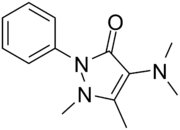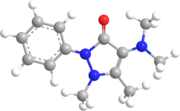Aminophenazone
From Wikipedia, the free encyclopedia
 |
|
 |
|
| Systematic (IUPAC) name | |
|---|---|
|
4-Dimethylamino-1,5-dimethyl-2-phenylpyrazol-3-one
|
|
| Clinical data | |
| AHFS/Drugs.com | International Drug Names |
| Pharmacokinetic data | |
| Metabolism | N-demethylation[1] |
| Identifiers | |
| CAS Number | 58-15-1 |
| ATC code | N02BB03 (WHO) |
| PubChem | CID 6009 |
| DrugBank | DB01424 |
| ChemSpider | 5787 |
| UNII | 01704YP3MO |
| KEGG | D00556 |
| ChEBI | CHEBI:160246 |
| ChEMBL | CHEMBL288470 |
| Chemical data | |
| Formula | C13H17N3O |
| Molar mass | 231.29358 |
| 3D model (Jmol) | Interactive image |
|
|
|
|
| (verify) | |
Aminophenazone (or aminopyrine) is a pyrazolone with analgesic, anti-inflammatory, and antipyretic properties but has risk of agranulocytosis. A breath test with 13C-labeled aminopyrine has been used as a non-invasive measure of cytochrome P-450 metabolic activity in liver function tests.[1] It is also used in measuring the total body water in the human body system.[2]
References[edit]
- ^ a b Caubet, M. S.; Laplante, A.; Caillé, J.; Brazier, J. L. (4 Jan 2007). "[13C]Aminopyrine and [13C]Caffeine Breath Test: Influence of Gender, Cigarette Smoking and Oral Contraceptives Intake". Isotopes in Environmental and Health Studies. 38 (2): 71–77. doi:10.1080/10256010208033314.
- ^ "Aminophenazone — Compound Summary". PubChem. The National Library of Medicine. 2005-03-26. Retrieved June 12, 2008.
| This analgesic-related article is a stub. You can help Wikipedia by expanding it. |